Celebrating 600 years of Admiral Zheng He’s Teasure Feets
Welcome to Mike Boss’ Artist Gallery. This Gallery displays 4 of his latest works, inspired by the great Treasure Fleets of 1421.
Mike Boss – wheaterdog@ yahoo.com
Sunell Koerner – sunell@ruraltel.net
Voyagers to America
Some years back I saw a wonderful graphic by illustrator Jan Adkins showing the relative size of Columbus’ Santa Maria to Zheng He’s Treasure Ship. It gave me the idea to develop a painting that would also include a Viking Longship. The Longship and the Santa Maria were basically the same length and I thought displaying both in front of the large bow of the Baochuan would be the way to image the three ships. It’s quite a demonstration of the extraordinary contrast in size of these three magnificent seafaring vessels.
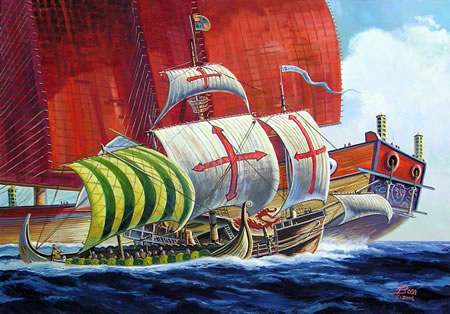
The Admiral and his Baochuan
Having finished the first painting with a look of the big ocean and the fleet, I wanted to go in the opposite direction. A rendering at night with the big baochuan- “in your face”-was a given. I am particularly fond of paintings in the vertical and after painting some small studies or “comps”, the idea was set.
I have a particular fondness for night paintings as I spend much of my time under the stars to gather my composure and refresh my spirit. It does not take a lot of imagination to hear the slosh of the bow wake, the creaking and groaning of the ship and to see the subtle light from the lanterns. I kind of like the eyes and the man-tiger as well. What a sight it would have been to see the big treasure ships at night.
Original painting is Shiva Casein on Crescent rag
illustration board. 24″ X 18″
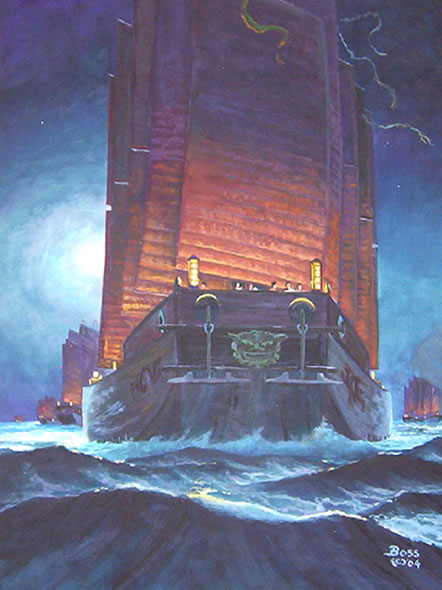
Zheng He and the Great Treasure Fleet
Red sails seem to predominate in the literature. From information from my Chinese researchers, the red at that time was not the bright red of today but a more earthy red. Every Ming drawing has the eyes and dragon near the bow. That is a natural. Many paintings of Chinese junks from the nineteenth and twentieth century display what appear to be black hulls. Some of my compatriots did not believe black would have been used in Zheng He’s time as it was a color of war. I decided to leave the hulls a natural wood color. Several current renderings from China have the earthy red on the top portion above the main deck. Right or wrong, it looks good.
Length and beam are certainly being debated by academics and others. I have read the ships could not have been built over 300 feet in length as they would have fallen apart in the water. Most always the skeptic, I saw nothing in any scientific literature that could prop up the theory. After corresponding with Cedric Bell, who has discovered and recorded two of the great baochuans with magnetic anamoly surveys, did indeed verify their length at 150 meters.
The painting took three months to complete. When one is having a debut it can be a bit intimidating. I think for a first effort it is a success!
Original painting is Shiva Casein on Crescent rag illustration board. 20″ X 30″
There have been many challenging paintings in my years of art but none like Zheng He’s treasure ships. Artists are often taught to paint from life. However, there seem to be no specific drawings or art of the great Ming Dynasty ships let alone any 1/1 examples! Extant are a few drawings of smaller craft, and they indeed provide clues to the development of the paintings. All show vertically rigged rectangular sails. Mention of nine masts and twelve sails leads me to believe there were three main masts and each had two sails. Split sails would have been much easier to raise and lower.
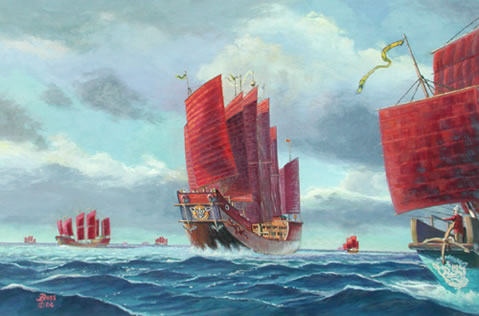
The Admiral and Siam
As it happens, I have always liked karst geology. Erosion processes of certain sedimentary rock is labeled tower and cone. I became aware of cone karsts when young and reading World War II era books about the American Volunteer Group nicknamed the Flying Tigers. In those books were inspiring P-40 photos but somehow I keyed on the strange mountains near Guilin, China.
Years later, during the Viet Nam War, pictures of Halong Bay and its towers were published. Mentally “filing” these images for years, I was researching Thailand and became aware of its karsts . Knowing Zheng He’s fleet would have sailed to then Siam, it was a “done deal”.
The painting presented no special problems as I worked from several photographs of Thai tower karsts and arranged a pleasing composition. Too, I wanted the big baochuans in the distance and the little fishing boats in the foreground.
Shiva Casein on Crescent rag illustration board. 18″ X 30″
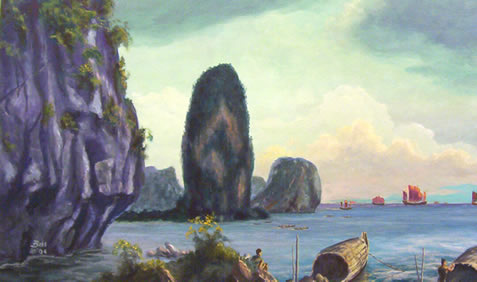
Biography
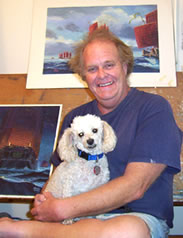 Mike Boss is a native of Kansas and has painted most of his life. Early on he was introduced to a big world and the much larger cosmos. He was quite aware that painting and history were linked. While growing up he was reading “Fighting the Flying Circus”, “men’s” magazines with swash-buckling illustrations, books on dinosaurs, and outer space. The world then and now, as well as the cosmos, fought hard against the mandatory and rather perfunctory years of grade school.
Mike Boss is a native of Kansas and has painted most of his life. Early on he was introduced to a big world and the much larger cosmos. He was quite aware that painting and history were linked. While growing up he was reading “Fighting the Flying Circus”, “men’s” magazines with swash-buckling illustrations, books on dinosaurs, and outer space. The world then and now, as well as the cosmos, fought hard against the mandatory and rather perfunctory years of grade school.
Growing up during the cold war was a very interesting time for someone who loved aviaton and space. Mike does not remember “duck and cover” but running outside to see a KC-97 refueling a B-47. As with many young boys, Mike was no different in that most built the new-rage plastic model kits. Some models themselves were really quite imaginative but what captured him for life was the spectacular box art by Jo Kotula, Ray Gaedke, John Steel, Brian Knight, and most of all, Jack Leynnwood.
After graduating from high school Mike majored in music as a double bass player. While attending Southern Illinois University he called his childhood hero, Jack Leynnwood. For several years he had kept an article from Private Pilot magazine, and rereading it, decided to touch base with his hero and soon-to-be mentor. The rest is history.
Years later Mike decided to go full time as an illustrator. Jack Leynnwood was a treasure trove of insight on composition, taste, and getting the right look. Never one to hide ideas and technique or play silly ethereal art games, he was always willing to share his knowledge.
Over the years Mike has painted about everything: aviation, space, rail, marine, landscapes ,etc., as he is not into the groove of being a genre painter of one or two subjects. “Life is way too short and there are so many, many things to paint and sadly, with any artist, they won’t all happen.” He has won his share of awards etc., but it isn’t of primary importance. The greatest award is the look on people’s faces when the ideas in the painting “hit.” He loves when a chord strikes and viewers go out with piqued interest in a subject.
In 2003, Mike was browsing in the local library and found a new book on great ships written and illustrated by Patrick O’Brien. Looking through the gorgeous publication he saw a fabulous painting of a humungous Chinese junk. That begged the question–who was Cheng Ho? Right away a search on the internet was done and the first hit to come up was Gavin Menzies’ site 1421. Right away he knew he was on to something. Cheng Ho, now Zheng He was a complete mystery, and Mike’s knowledge of history had missed this “by a country mile.” It did not take a long time to start piecing things together.
After months of researching the history of the treasure fleets, he absolutely knew paintings of this historical event had to be attempted. Even though there seemed to be few images even remotely resembling the baochauns, written measurements, descriptions, and Ming Dynasty drawings of smaller ships or boats, painting these treasure ships could make for a more than educated guess.
A friend of Mike’s, Mary Ridgway, is an ardent admirer of things Asian and was a terrific idea person and sounding board for discussion concerning decoration of the treasure ships. After looking at a number of references they agreed the ships were probably not painted but retained their natural wood colors. Two renderings from China show the old Chinese red on the upper portion of the hull above the main deck. It looked good and Mike went with these colors.
References tell of the big ships having nine masts and twelve sails. Mike’s guess was that the main masts had two sails each as they would have been much easier to raise and lower. However, he believes there may have been several types of sail rigging. Time will tell as lost documents are found and artifacts unearthed. Sail and rigging technology could have very well changed in the seven voyages.
The paintings are casein–one of the artist’s favorite mediums. Much to Mike’s delight, Jack Richeson and Company of Kimberly, Wisconsin, purchased the trade name “Shiva” and have restored casein to its former glory and quality.
For Mike Boss, other subjects will appeal to his artistic sense, but he is quite certain Zheng He and the treasure fleets will be sailing around in his mind and on his canvases for some time to come.

